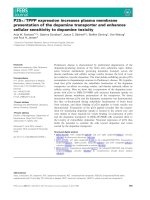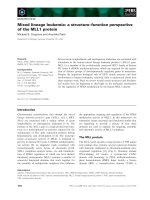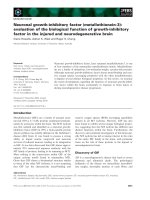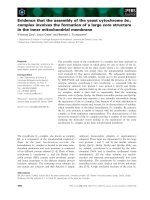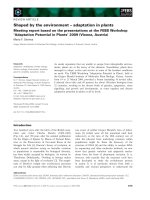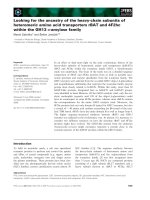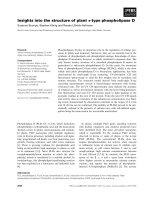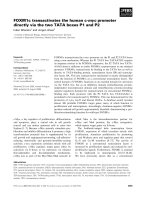Báo cáo khoa học: Geraniol dehydrogenase, the key enzyme in biosynthesis of the alarm pheromone, from the astigmatid mite Carpoglyphus lactis (Acari: Carpoglyphidae) docx
Bạn đang xem bản rút gọn của tài liệu. Xem và tải ngay bản đầy đủ của tài liệu tại đây (321.44 KB, 11 trang )
Geraniol dehydrogenase, the key enzyme in biosynthesis
of the alarm pheromone, from the astigmatid mite
Carpoglyphus lactis (Acari: Carpoglyphidae)
Koji Noge
1,
*, Makiko Kato
1
, Naoki Mori
1
, Michihiko Kataoka
1
, Chihiro Tanaka
2
, Yuji Yamasue
3
,
Ritsuo Nishida
1
and Yasumasa Kuwahara
1,
†
1 Division of Applied Life Sciences, Graduate School of Agriculture, Kyoto University, Japan
2 Division of Environmental Science and Technology, Graduate School of Agriculture, Kyoto University, Japan
3 Division of Agronomy and Horticultural Science, Graduate School of Agriculture, Kyoto University, Japan
Keywords
alarm pheromone; biosynthesis;
Carpoglyphus lactis; geraniol
dehydrogenase; monomeric alcohol
dehydrogenase
Correspondence
K. Noge, Department of Entomology,
University of Arizona, Tucson, AZ 85721,
USA
Fax: +1 520 621 1150
Tel: +1 520 621 1328
E-mail:
Present address
*Department of Entomology, University of
Arizona, Tucson, AZ, USA
†Department of Bioscience and Biotech-
nology, Faculty of Bioenvironmental Science,
Kyotogakuen University, Kameoka, Japan
Database
Nucleotide sequence data are available in the
DDBJ ⁄ EMBL ⁄ GenBank databases under the
accession numbers AB305641 and
AB305642
(Received 30 October 2007, revised 20
March 2008, accepted 25 March 2008)
doi:10.1111/j.1742-4658.2008.06421.x
Geraniol dehydrogenase (GeDH), which plays an important role in the bio-
synthesis of neral, an alarm pheromone, was purified from the astigmatid
mite Carpoglyphus lactis. The enzyme was obtained in an apparently homo-
geneous and active form after 1879-fold purification through seven steps of
chromatography. Car. lactis GeDH was determined to be a monomer in its
active form with a relative molecular mass of 42 800, which is a unique
subunit structure in comparison with already established alcohol dehydro-
genases. Car. lactis GeDH oxidized geraniol into geranial in the presence
of NAD
+
. NADP
+
was ineffective as a cofactor, suggesting that Car.
lactis GeDH is an NAD
+
-dependent alcohol dehydrogenase. The optimal
pH and temperature for geraniol oxidation were determined to be pH 9.0
and 25 °C, respectively. The K
m
values for geraniol and NAD
+
were
51.0 lm and 59.5 lm, respectively. Car. lactis GeDH was shown to selec-
tively oxidize geraniol, whereas its geometrical isomer, nerol, was inert as a
substrate. The high specificity for geraniol suggests that Car. lactis GeDH
specializes in the alarm pheromone biosynthesis of Car. lactis. Car. lactis
GeDH is composed of 378 amino acids. Structurally, Car. lactis GeDH
showed homology with zinc-dependent alcohol dehydrogenases found in
mammals and a mosquito (36.6–37.6% identical), and the enzyme was
considered to be a member of the medium-chain dehydrogenase ⁄ reductase
family, in view of the highly conserved sequences of zinc-binding and
NAD
+
-binding sites. Phylogenetic analyses indicate that Car. lactis GeDH
could be categorized as a new class, different from other established
alcohol dehydrogenases.
Abbreviations
ADH, alcohol dehydrogenase; CAD, cinnamyl alcohol dehydrogenase; GeDH, geraniol dehydrogenase; MDR, medium-chain
dehydrogenase ⁄ reductase.
FEBS Journal 275 (2008) 2807–2817 ª 2008 The Authors Journal compilation ª 2008 FEBS 2807
Communication in insects and other arthropods,
including mites, is mostly established by chemical sig-
nals. Pheromones play an essential role in communica-
tive signals between individuals of the same species in
relation to mating, aggregation, escape, and other
behaviors. Since bombykol [( E,Z)-10,12-hexadecadien-
1-ol] was isolated as a sex pheromone of the silkmoth,
Bombyx mori [1], a wide variety of chemicals, such as
terpenoids, fatty acid derivatives (alcohols, aldehydes,
esters, and hydrocarbons), phenolics, and alkaloids,
have been identified as pheromones from thousands of
insects, mites, and other arthropods.
Astigmatid mites secrete various kinds of monoterp-
enes, such as neral [(Z)-3,7-dimethyl-2,6-octadienal],
(2R,3R)-epoxyneral [(2R,3R)-epoxy-3,7-dimethyl-6-
octenal] and a-acaridial [2(E)-(4-methyl-3-pentenyl)-
butenedial], and some of these compounds are known
to function as alarm, aggregation and sex pheromones
[2]. Neral has the basic skeleton of most of the mite
monoterpenes. Because of this, neral is thought to be a
key compound in the monoterpene biosynthesis of
mites. Neral is one of the most widely distributed mite
monoterpenes. It is present in 35 of 60 species of astig-
matid mites examined, including 28 unidentified species
[2]. Neral has been identified as the alarm pheromone
in six mite species, including Carpoglyphus lactis [3–7].
This compound was also identified as the aggregation
pheromone of Schwiebea elongata [8] and as the sex
pheromone of Histiogaster sp. [9]. Furthermore, it was
reported that a mixture of neral and geranial [(E)-3,7-
dimethyl-2,6-octadienal] secreted from astigmatid mites
had an antifungal effect on Aspergillus fumigatus [10].
From these facts, it has been suggested that neral plays
important roles in the survival of astigmatid mites in
relation to chemical communication and defense. In
Car. lactis, neral is biosynthesized via the mevalonate
pathway [11]. A recent study showed that neral was
biosynthesized from geraniol in Car. lactis [12]: gera-
niol was first oxidized to geranial by NAD
+
-depen-
dent geraniol dehydrogenase (GeDH; EC 1.1.1.183),
and then geranial was isomerized to neral (Fig. 1). In
general, neral and geranial are present as a mixture in
thermodynamic equilibrium (citral; neral ⁄ geranial =
4 : 6). In the secretion of Car. lactis, however, the
neral ⁄ geranial ratio is 95 : 5 and is thus different from
that of citral [3,12]. Although in this previous study
large amounts of neral were not produced in vitro, the
enzyme solution obtained from Car. lactis converted
citral into a different composition of isomers (geranial ⁄
neral = 1 : 1). Therefore, it suggested that there was
some enzymatic factor related to the isomerization
from geranial to neral in Car. lactis [12]. The activities
of GeDH have been reported in four plant materials
(lemongrass, Cymbopogon flexuosus [13], orange fruit
[14], ginger, Zingiber officinale [15], and sweet basil,
Ocimum basilicum [16]), and two microorganisms
(Pseudomonas aeruginosa [17] and Penicillium digitatum
[18]). However, there is only one example of the pres-
ence of GeDH in an animal source, i.e. Car. lactis [12].
Therefore, the enzymatic characteristics of animal
GeDH and its relationship to other GeDHs are still
unknown.
This article reports the first purification to homoge-
neity of GeDH from an animal. We elucidated its
enzymatic characteristics associated with the alarm
pheromone biosynthesis. We also report the nucleotide
and amino acid sequences of Car. lactis GeDH. On
the basis of the comparison of enzymatic properties
and protein sequences, Car. lactis GeDH is suggested
to be a new class, differing from the already estab-
lished alcohol dehydrogenases (ADHs). This is also the
first report of the primary structure determination of
GeDH from an animal.
Results
Purification of GeDH from Car. lactis
Car. lactis GeDH was purified to homogeneity via a
seven-step protocol, which is summarized in Table 1.
The final recovery of Car. lactis GeDH was 1.4% with
1879-fold purification. Gel filtration chromatography
on a Superdex 75 column of the purified enzyme
resulted in a single peak of protein, corresponding to
GeDH activity, with a calculated relative molecular
Fig. 1. Biosynthetic pathway of neral in Car. lactis. Geraniol, which
is biosynthesized via the mevalonate pathway [11], is first oxidized
to geranial by NAD
+
-dependent geraniol dehydrogenase (1), and
then geranial is isomerized to neral [12]. Nerol is not oxidized
directly to neral [12].
Geraniol dehydrogenase from Carpoglyphus lactis K. Noge et al.
2808 FEBS Journal 275 (2008) 2807–2817 ª 2008 The Authors Journal compilation ª 2008 FEBS
mass of 56 200. Native PAGE of the purified enzyme
gave a single band (data not shown). SDS ⁄ PAGE of
the purified enzyme showed a single band, with a cal-
culated relative molecular mass of 42 800 (Fig. 2). No
other bands corresponding to the difference (about
13 000) between native and denatured enzymes were
detected by SDS ⁄ PAGE. In addition to this, the rela-
tive molecular mass of the native enzyme was less than
that expected for a homodimer. These observations
suggest that Car. lactis GeDH may be active as a
monomer.
Catalytic properties for geraniol oxidation
Purified Car. lactis GeDH required only NAD
+
for
the oxidation of geraniol. NADP
+
was ineffective as a
cofactor, suggesting that Car. lactis GeDH is an
NAD
+
-dependent ADH. The effect of temperature on
the geraniol oxidation activity is shown in Fig. 3. The
optimal temperature was estimated to be 25 °C. The
geraniol oxidation activity increased under basic condi-
tions (Fig. 4). As the pH increased from 7.0 to 7.5,
there was a sharp increase in GeDH activity, whereas
Table 1. Purification of GeDH from Car. lactis.
Purification step
Total
protein
(mg)
Total
activity
(units)
Specific
activity
(unitsÆmg
)1
)
Yield
(%)
Purification
(fold)
Crude enzyme 7233 119 0.016 100 1.0
(NH
4
)
2
SO
4
precipitate 4913 87 0.018 73 1.1
TOYOPEARL Phenyl-650M 100 24 0.24 20 15
TOYOPEARL HW-50F 70 11 0.16 9.2 9.6
DEAE–cellulose 8.9 9.4 1.1 7.9 64
Blue-Cellulofine 0.88 6.4 7.3 5.4 442
Superdex 200 0.35 3.6 10 3.0 625
MonoQ 0.055 1.7 31 1.4 1879
Fig. 2. SDS ⁄ PAGE of purified Car. lactis GeDH. Lane 1, standard
mixture (see Experimental procedures); lane 2, purified enzyme.
Proteins were stained with silver reagent.
Fig. 4. pH activity profile of purified Car. lactis GeDH. Activity was
measured using 0.1 m
M NAD
+
and 0.1 mM geraniol. The buffers
used were: 50 m
M potassium dihydrogen citrate ⁄ NaOH
(pH 4.0–6.0); 50 m
M potassium dihydrogen phosphate ⁄ NaOH
(pH 6.0–7.5); 50 m
M Tris ⁄ HCl (pH 7.0–8.5); and 50 mM glycine ⁄
NaOH (pH 8.5–10.5). The geraniol oxidation activity was inhibited in
potassium phosphate buffer.
Fig. 3. Temperature dependence of geraniol oxidation by purified
Car. lactis GeDH. The oxidation activities at different temperatures
were estimated as consumption of the substrate, geraniol.
K. Noge et al. Geraniol dehydrogenase from Carpoglyphus lactis
FEBS Journal 275 (2008) 2807–2817 ª 2008 The Authors Journal compilation ª 2008 FEBS 2809
the activity decreased sharply beyond pH 10.0. The
optimal pH was determined to be 9.0. The enzyme
exhibited typical Michaelis–Menten kinetics with gera-
niol as well as NAD
+
. The K
m
values for geraniol and
NAD
+
were determined from a Lineweaver–Burk plot
(data not shown) as 51.0 lm and 59.5 lm, respectively.
The affinity of the enzyme for geraniol was almost the
same as that for NAD
+
. k
cat
and k
cat
⁄ K
m
values for
geraniol were 2996 s
)1
and 58.8 s
)1
Ælm
)1
. To calculate
the k
cat
value, the relative molecular mass of the native
enzyme was calculated from the deduced amino acid
sequence (40 630, described below).
Substrate specificity
The substrate specificity of purified Car. lactis GeDH
is shown in Table 2. Geraniol, a trans-allylic alcohol,
was selectively oxidized by the enzyme. Nerol, the geo-
metrical isomer of geraniol, was inert as a substrate.
Saturation of the 2,3-double bond of geraniol, giving
citronellol, resulted in a marked decrease in the oxida-
tion activity. These results indicate that Car. lactis
GeDH could recognize the geometrical isomers clearly.
An increase of one in the number of isoprene units of
geraniol, giving E,E-farnesol, resulted in a drastic
decrease in the oxidation activity (50%). The relative
activity was 4.3% for 3-methyl-2-buten-1-ol, which
corresponds to an allylic alcohol with one isoprene
unit. Straight-chain alcohols such as 1-octanol,
2-buten-1-ol, 1-butanol and ethanol served as poor
substrates. These results suggest that the enzyme can
recognize allylic alcohols with carbon chain lengths of
at least more than five.
Sequence analysis
A sequence of 42 N-terminal amino acid residues of
purified Car. lactis GeDH was identified as shown in
Fig. 5. The N-terminus (valine) was detected by
Edman degradation. It is suggested that at least valine
as the first residue was not blocked by acetylation. The
N-terminal residues of the enzyme shared 38.1% simi-
larity to two plant ADHs: tomato, Solanum lycopersi-
cum (Swiss-Prot ⁄ TrEMBL primary accession number
Q41242), and potato, Solanum tuberosum (Q43169), by
blast search. A specific degenerate primer was
designed on the basis of the N-terminal amino acid
sequence at position 18–25 (see Experimental proce-
dures). The degenerate primer used in PCR generated
a cDNA fragment encoding the enzyme with a size of
approximately 1.1 kbp (Fig. 5). On the basis of the
cDNA sequence, gene-specific primers were designed,
and then the nucleotide sequence corresponding to the
N-terminal residues of purified Car. lactis GeDH at
position 1–32 was determined by inverse PCR using
genomic DNA (Fig. 5). The N-terminal sequence
deduced from this nucleotide sequence completely
matched with that determined by Edman degradation,
and no intron was detected in this region. Although
the residues at positions 11, 35 and 40 were not identi-
fied by Edman degradation, these residues were identi-
fied as a cysteine, a proline, and a valine, respectively,
on the basis of the deduced amino acid sequence.
Car. lactis GeDH was composed of 378 amino acids
and its relative molecular mass was 40 630, which
approximately corresponds to the 42 800 determined
by SDS ⁄ PAGE. The blast search revealed that the
deduced amino acid sequence of Car. lactis GeDH has
similarity to the zinc-dependent ADHs found in vari-
ous kinds of vertebrates (36.7% identical to ostrich,
Struthio camelus, class II, P80468; 36.6% identical to
Norway rat, Rattus norvegicus, class III, P12711;
37.6% identical to Japanese medaka, Oryzias latipes,
class III, Q6R5I9), and a yellow fever mosquito,
Aedes aegypti (37.6% identical, Q176A7). The ATG
sequence was found next to the first valine of the puri-
fied enzyme, which may correspond to an initiator
methionine. A typical TATA box was not detected in
the 201 bp upstream from the probable initiator codon
(data not shown; see AB305642 deposited in the
DDBJ ⁄ EMBL ⁄ GenBank databases).
Phylogenetic analysis
The protein distance tree was constructed by using
protein sequences related in both primary structure
and substrate specificity to Car. lactis GeDH: ADHs,
cinnamyl alcohol dehydrogenases (CADs), Oc. basili-
cum GeDH, and two 10-hydroxygeraniol oxidoreduc-
tases, as shown in Fig. 6. ADHs found in
microorganisms (yeast ADHs and Neurospora ADH)
Table 2. Substrate specificity of Car. lactis GeDH. Activities were
determined in 50 m
M Tris ⁄ HCl (pH 8.5), in the presence of 0.1 mM
NAD
+
and 0.1 mM each alcohol.
Substrate
Relative
activity (%)
Geraniol 100
Nerol 0.0
Citronellol 4.3
E,E-Farnesol 50
3-Methyl-2-buten-1-ol 4.3
1-Octanol 3.7
1-Butanol 2.5
2-Buten-1-ol 3.1
Ethanol 1.2
Geraniol dehydrogenase from Carpoglyphus lactis K. Noge et al.
2810 FEBS Journal 275 (2008) 2807–2817 ª 2008 The Authors Journal compilation ª 2008 FEBS
were used as outgroups. The tree was separated into
three major groups, and the monophyly of each was
supported by a high bootstrap value. The first group
consisted of ADHs obtained from both animals and
plants. The second group consisted of two groups:
plant CADs and three other geraniol-related dehydro-
genases. The third group consisted of Car. lactis
GeDH. The topologies of the trees obtained from both
maximum parsimony and minimum evolution criteria
were congruent, except for the position of Oryzias
Fig. 5. Nucleotide and deduced amino acid
sequences of Car. lactis GeDH. The single-
letter code translated amino acid sequence
is indicated below the nucleotide sequence
from positions 1 to 1134 (as 378 amino
acids). Nucleotide and amino acid positions
are indicated on the right and left, respec-
tively. Underlined amino acids were deter-
mined by N-terminal sequence analysis from
the purified enzyme. An asterisk shows the
termination codon (TAA). The nucleotide
from positions 1168 to 1176 was poly(A).
The nucleotide sequence marked by a
dotted line was identified as a genomic
DNA sequence. Catalytic and noncatalytic
zinc-binding residues are shown by arrows
and arrowheads, respectively. The glycine-
rich region (GXGXXG) corresponding to the
NAD
+
-binding domain is in bold.
K. Noge et al. Geraniol dehydrogenase from Carpoglyphus lactis
FEBS Journal 275 (2008) 2807–2817 ª 2008 The Authors Journal compilation ª 2008 FEBS 2811
latipes ADH class VI. In the parsimony tree, Oryz-
ias latipes ADH class VI was the sister group of the
cluster consisting of all other animal ADHs.
Discussion
On the basis of differences in relative molecular mass,
subunit composition, and cofactor requirement,
Car. lactis GeDH should probably be classified sepa-
rately from animal and plant ADHs, and plant GeD-
Hs. Our results suggest that the purified Car. lactis
GeDH may have a monomeric structure as an active
enzyme. The discrepancy in relative molecular mass
between the native and denatured forms might reflect
the tertiary structure of the native enzyme. The calcu-
lated relative molecular mass based on the deduced
378 amino acids of Car. lactis GeDH was 40 630,
which is almost consistent with that determined by
SDS ⁄ PAGE. The difference between the relative
molecular masses of Car. lactis GeDH determined by
SDS ⁄ PAGE and calculated from the deduced amino
acid sequence may be due to the mobility of the
enzyme on the gel or post-translational modification.
ADHs thus far purified from plants [19,20], animals,
including insects [21,22], and microorganisms [23,24]
commonly function as dimers or oligomers. However,
the subunit structure of Car. lactis GeDH was quite
different from that of other ADHs. As far as we
know, there is only one other example of a mono-
meric ADH with activity, isolated from the Indian
snakeroot, Rauwolfia serpentina [25]. The relative
molecular mass of the purified dehydrogenase from
Rau. serpentina is about 50 000 on the basis of gel fil-
tration chromatography, and 44 000 by SDS ⁄ PAGE,
and is thus comparable to that of Car. lactis GeDH.
GeDHs have been partially purified from two plant
sources, lemongrass [13] and orange [14]. The relative
molecular masses of native GeDH from these materi-
als are 84 000 and 92 000, respectively. Although the
subunit composition of these GeDHs was not deter-
mined, the relative molecular mass determined for
native Car. lactis GeDH is smaller than that of either
GeDH obtained from the above two species. More-
over, the requirement for a cofactor (NADP
+
) of the
Fig. 6. Phylogenetic tree based on amino
acid sequences of Car. lactis GeDH and
other ADHs by minimum evolution criterion.
The scale of the distances is shown under
the tree. The tree is separated into three
groups (group 1, ADHs from animals and
plants; group 2, CADs and geraniol-related
dehydrogenases; and group 3, Car. lactis
GeDH). 10H-GeDH indicates 10-hydroxy-
geraniol oxidoreductase. The numbers at
the nodes represent the percentage of boot-
strap confidence level (more than 50% is
indicated).
Geraniol dehydrogenase from Carpoglyphus lactis K. Noge et al.
2812 FEBS Journal 275 (2008) 2807–2817 ª 2008 The Authors Journal compilation ª 2008 FEBS
GeDHs obtained from lemongrass [13], orange [14]
and sweet basil [16] was also different from that of
Car. lactis GeDH.
The results from this study suggest that Car. lactis
GeDH specializes in the biosynthesis of neral, the
alarm pheromone of Car. lactis. This enzyme showed
much greater specificity for the oxidation of geraniol
than other alcohols tested (Table 2), and the properties
of the enzyme were highly consistent with the biosyn-
thetic pathway of neral in Car. lactis (Fig. 1). A previ-
ous study has also shown that the oxidation of
geraniol is one of the key steps in the production of
neral [12]. The low amount of the enzyme may be due
to its specific role in alarm pheromone biosynthesis.
Citral, a mixture of neral and geranial, is known to
have antifungal activity against As. fumigatus [10],
Penicillium italicum, and two other pathogens [26].
Citral has also been reported to have a repellent effect
on ants [27], which are possible predators in nature.
These facts suggest that neral plays essential roles in
the survival of Car. lactis. The high specificity of
Car. lactis GeDH for geraniol might be driven by
selective pressure to develop an ecologically advanta-
geous character for the survival of this mite, efficient
neral production. Car. lactis GeDH showed 50% oxi-
dation activity with farnesol. Oxidation of farnesol is
related to the biosynthesis of insect juvenile hormone
[28,29]. As far as we know, there is no report of the
presence of farnesal and its related compounds (e.g.
juvenile hormones) in Car. lactis, so we cannot deter-
mine the biological significance of farnesol oxidation
by Car. lactis GeDH at this time. The pH range
suitable for alcohol oxidation by Car. lactis GeDH is
similar to that of other ADHs [22,30–32].
The highly conserved sequences of zinc-binding and
NAD
+
-binding sites as compared to other ADHs
suggest that Car. lactis GeDH belongs to the med-
ium-chain dehydrogenase ⁄ reductase (MDR) family
[33]. Comparison of the amino acid sequence of
Car. lactis GeDH with that of other ADHs shows
that seven residues implicated in the zinc-binding site
are strictly conserved (Fig. 5). Three residues (Cys48,
His75, and Cys179) and four cysteine residues
(Cys105, Cys108, Cys111, and Cys119) in Car. lactis
GeDH may serve as catalytic and noncatalytic zinc-
binding sites, respectively. Our preliminary study
showed that the geraniol oxidation activity of
Car. lactis GeDH was inhibited by preincubation with
50 mm EDTA. However, the activity did not recover
after addition of bivalent cation (Zn
2+
,Cu
2+
,Mn
2+
,
or Co
2+
) to the inactivated enzyme by EDTA
treatment. Gel filtration chromatography of the
inactivated enzyme showed an increase of apparent
relative molecular mass as compared to the native
enzyme (data not shown). It is thus possible that
EDTA treatment leads to an irreversible structural
change of Car. lactis GeDH that is coupled with its
activity. Although the essential metal ion has not
been identified, these results show that Car. lactis
GeDH requires the metal ion for its oxidation activity
and structural maintenance. The glycine-rich region
(position 204–209, GLGGIG) is also conserved in
Car. lactis GeDH (Fig. 5), and has been found in the
NAD
+
-binding site in ADHs [34]. The absence of the
probable initiator methionine in the native enzyme
may be due to the N-terminal processing commonly
observed in eukaryotic proteins [35].
Our phylogenetic analyses of the MDR family sug-
gest that Car. lactis GeDH should be categorized as
a new class of ADH. The primary structure of Car.
lactis GeDH was more similar to animal ADHs (e.g.
ostrich ADH class II and Ae. aegypti ADH) than to
CADs and geraniol-related dehydrogenases (basil
GeDH and two 10-hydroxygeraniol oxidoreductases)
obtained from plants. The requirement for NAD
+
for
oxidation was shared by other ADHs, whereas CADs
and geraniol-related dehydrogenases require NADP
+
for their alcohol oxidation activity. On the other hand,
the substrate specificity of Car. lactis GeDH was quite
different from that of other ADHs, in that Car. lactis
GeDH never oxidized ethanol. The capability for gera-
niol oxidation was shared by basil CAD and GeDHs
found in basil, lemongrass, orange, and ginger. The
characteristics of Car. lactis GeDH seem to be a
hybrid between those of animal ADHs and plant
CADs in relation to primary structure and substrate
specificity.
In this article, we have reported that Car. lactis
GeDH functions as a monomer, which is a unique sub-
unit structure, and that this enzyme enables Car. lactis
to produce neral efficiently. We also determined the
primary structure of Car. lactis GeDH, which
suggested that it should be categorized as a new class
of ADHs, different from other ADHs, plant CADs,
and plant GeDHs.
Experimental procedures
Mite
Car. lactis Linnaeus (Acari: Carpoglyphidae) was originally
of a strain maintained at Tokyo Women’s Medical College.
The strain was maintained at 25 °C and 75% relative
humidity, and fed a mixture of dry yeast and sugar (1 : 1)
at the Laboratory of Chemical Ecology, Kyoto University,
Japan.
K. Noge et al. Geraniol dehydrogenase from Carpoglyphus lactis
FEBS Journal 275 (2008) 2807–2817 ª 2008 The Authors Journal compilation ª 2008 FEBS 2813
Enzyme assay
GeDH activity was assayed by monitoring the formation of
NADH at 340 nm in a DU-64 spectrophotometer (Beck-
man Coulter Inc., Fullerton, CA, USA) at room tempera-
ture. Each assay was performed with 50 lL of reaction
mixture containing 50 mm Tris ⁄ HCl (pH 8.5), 0.1 mm
NAD
+
, 0.1 mm geraniol, and 1 lL of enzyme source. The
reaction was started by adding l lL of the crude enzyme
solution or partially purified fractions. One unit is defined
as the amount of enzyme needed to generate 1 lmol NAD-
HÆmin
)1
. For determining the catalytic properties,
10 lgÆmL
)1
purified enzyme was used in each assay. The
protein concentration was determined by the Coomassie
Blue method of Bradford [36], using BSA as a standard. To
estimate the effect of temperature on the geraniol oxidation
activity, the same reaction was performed at 4, 16, 25, 37
and 60 °C. After 30 min, the reaction mixture was extracted
with the same quantity of hexane containing 5 p.p.m. octa-
decane as an internal standard. The extract (3 lL) was
subjected to GC and GC ⁄ MS analysis as previously
described [37]. Each compound was identified by comparing
its GC retention time and mass spectrum with those of
authentic compounds.
Enzyme purification
All purification procedures were carried out at 4 °C unless
otherwise stated. Mites (75 g) were separated from culture
media by suspending them in saturated saline. Medium-free
mites were left at 4 °C for more than 4 h. Initial experi-
ments indicated that this cold storage resulted in maximal
GeDH activity. Medium-free mites were then suspended in
50 mm Tris ⁄ HCl (pH 7.8) (buffer A) and homogenized
using an ultrasonic processor, Astrason (Misonix Inc.,
Farmingdale, NY, USA). The homogenate was centrifuged
(15 000 g, 30 min at 4 °C), and then the supernatant was
recovered as an enzyme source. The 30–60% ammonium
sulfate fraction was dissolved in 20% ammonium sulfate-
saturated buffer A. The protein solution was loaded onto a
TOYOPEARL Phenyl-650M column (2.0 · 18.6 cm; Tosoh
Corp., Tokyo, Japan) and eluted with buffer A. A com-
bined active fraction was loaded on a Toyoperal HW50-F
column (2.4 · 12 cm; Tosoh Corp.) and eluted with buf-
fer A. The active fractions were combined and loaded onto
a DEAE–cellulose column (Whatman DE52, 1.5 · 6.0 cm;
Whatman, Clifton, NJ, USA) and eluted with a gradient of
0–0.3 m NaCl in buffer A. A combined active fraction was
loaded onto a Blue-Cellulofine column (1.1 · 3.0 cm;
Seikagaku Corp., Tokyo, Japan) equilibrated with buffer A
containing 0.5 m NaCl, and eluted with buffer A containing
2mm NAD
+
. The active fractions were combined and
concentrated by ultrafiltration on a 10K Nanosep cen-
trifugal device (Pall Corp., East Hills, NY, USA). The solu-
tion was loaded onto a Superdex 200 HR 10 ⁄ 30 column
(Amersham Biosciences, Uppsala, Sweden) and eluted with
buffer A at 18 °C using an A
¨
KTA explorer 10S system
(Amersham Biosciences). A combined active fraction was
concentrated by ultrafiltration and loaded onto a MonoQ
HR 5 ⁄ 5 column (Amersham Biosciences) at 18 °Conan
A
¨
KTA explorer 10S system. After elution with a gradient
of 0–0.3 m NaCl in buffer A, the active fractions were
combined. A combined active fraction was desalted and
then diluted to 10 lgÆmL
)1
in buffer A for enzyme assay.
Determination of relative molecular mass
The apparent relative molecular mass of the purified
Car. lactis GeDH was determined by gel filtration chroma-
tography using a Superdex 75 HR 10 ⁄ 30 column (Amer-
sham Biosciences) and by SDS ⁄ PAGE. The column was
eluted with buffer A at 18 °C. The following proteins were
used as M
r
standards: BSA (67 000), hen egg ovalbumin
(43 000), bovine chymotrypsinogen A (25 000), and bovine
ribonuclease A (13 700). SDS ⁄ PAGE was performed
according to the procedure of Laemmli [38], using the
following proteins as M
r
standards: rabbit phophorylase b
(97 000), BSA (66 000), chicken egg ovalbumin (45 000),
bovine carbonic anhydrase (30 000), soybean trypsin inhibi-
tor (20 100), and bovine a-lactalbumin (14 400).
N-terminal amino acid sequence analysis
One hundred micrograms of purified Car. lactis GeDH
from 351 g of fresh mites was transferred to a poly(vinyli-
dene difluoride) membrane (0.2 lm; Bio-Rad, Hercules,
CA, USA). Edman degradation was performed as described
by Honda et al. [39].
RNA isolation and cDNA cloning of Car. lactis
GeDH
Total RNA was isolated from 1 g of Car. lactis within
30 min after separation from culture media according to
Takano et al. [40]. Poly(A)
+
RNA was isolated using
Oligotex-MAG (Takara, Kyoto, Japan) according to the
manufacturer’s recommendation, and then was used for a
3¢-RACE reaction to synthesize first-strand cDNA using
an adapter (3¢-Full RACE core set; Takara)-linked oligo
(dT), 5¢-CTGATCTAGAGGTACCGGATCCTTTTTTTT
TT(A ⁄ G ⁄ C)-3¢, and SuperScript II reverse transcriptase
(Invitrogen, Carlsbad, CA, USA) according to the manu-
facturer’s recommendation. The cDNA was used directly
for PCR amplification using the primer corresponding to
an adapter as mentioned above and a specific degenerate
primer, gdh-n1 (5¢-AARGARGGICARCCIATGAARATH
GARCAR-3¢), designed on the basis of the partial N-termi-
nal amino acid sequence of Car. lactis GeDH. PCR was
performed in a 25 lL volume containing 0.63 units of Taq
Geraniol dehydrogenase from Carpoglyphus lactis K. Noge et al.
2814 FEBS Journal 275 (2008) 2807–2817 ª 2008 The Authors Journal compilation ª 2008 FEBS
DNA polymerase (Blend Taq; Toyobo, Osaka, Japan),
1· Blend Taq buffer, 0.2 mm dNTP, 0.4 lm each of the
two primers, and 1 lL of the cDNA as a template. The
PCR amplification was carried out as follows: an initial
step of 2 min at 94 °C, followed by 30 cycles with denatur-
ation at 94 °C for 30 s, annealing at 48 °C for 30 s, and
extension at 72 °C for 2 min. After the final cycle, the
products were extended for 5 min at 72 °C. An amplified
product of 1.1 kbp was isolated by agarose gel electro-
phoresis, purified, subcloned into the EcoRV site of the
vector pZErO
TM
-2 (Invitrogen), and sequenced. DNA seq-
uencing was performed as described in Yoshimi et al. [41].
Inverse PCR was performed with genomic DNA to
obtain the 5¢-region of the nucleotide sequence encoding
Car. lactis GeDH. Genomic DNA was isolated as described
in Noge et al. [42], and was then digested with a restriction
enzyme, HindIII (Takara), for 18 h at 37 °C. The digestions
were followed by self-ligation using T4 DNA ligase (MBI
Fermentas, St Leon-Rot, Germany). Inverse PCR was
performed using Ex Taq DNA polymerase (Takara) with
the self-ligated DNA as a template, and two primers,
gdh-in-1c (5¢-CCAGACGCTCAAGGATGGCAAC-3¢) and
gdh-in-1n (5¢-CTGGTGCCTGGATCAGGACCTG-3¢),
designed on the basis of the cDNA sequence encoding
Car. lactis GeDH. PCR parameters were 94 °C for 2 min
and 30 cycles of 94 ° C for 30 s, 60 ° C for 40 s, and 72 °C
for 4 min 30 s, followed by 72 °C for 5 min. Nested PCR
was carried out using another pair of primers, gdh-in-1c
and gdh-in-2n (5¢-GTGCCTGGATCAGGACCTGTTC-3¢),
and the previous PCR products diluted by 1% as a
template. The nested PCR reaction was performed with
some modifications of the methods for inverse PCR; 35
cycles, and annealing at 57 °C for 40 s. The sequence of the
resulting PCR product was determined as mentioned
above.
Phylogenetic analyses
To evaluate the relationship of Car. lactis GeDH to the
MDR family, the sequence data were selected on the basis of
the similarity of amino acid sequence and substrate specific-
ity to Car. lactis GeDH. Amino acid sequences correspond-
ing to several classes of ADH found in a wide range
of species (animals, including insects, plants, and micro-
organisms) were obtained from UniProtKB ⁄ Swiss-Prot and
UniProtKB ⁄ TrEMBL. Their origins and primary accession
numbers are as follows: human, Homo sapiens (ADH1A,
P07327; ADH1B, P00325; ADH1C, P00326; ADH4, P08319;
ADH5, P11766; ADH6, P28332; ADH7, P40394); Norway
rat, Rat. norvegicus (ADH4, Q64563; ADH class III,
P12711; class IV, P41682); ostrich, St. camelus (ADH1,
P80338; ADH class II, P80468); zebrafish, Brachydanio rerio
(ADH5, Q6NXA6); Japanese medaka, Oryzias latipes (ADH
class III, Q6R5I9; class VI, Q6B4J3); African clawed frog,
Xenopus laevis (ADH5, Q6EE34); Florida lancelet,
Branchiostoma floridae (ADH class III, Q9BBJ34); fruit fly,
Drosophila melanogaster (ADH class III, P46415); yellow
fever mosquito, Ae. aegypti (Q176A7); African malaria
mosquito, Anopheles gambiae (Q7Q8X4); rice, Oryza sativa
(ADH1, P20306; ADH2, P18332); potato, So. tuberosum
(ADH1, P14673; ADH2, P14674; ADH3, P14675); tomato,
So. lycopersicum (ADH2, P28032); baker’s yeast, Saccharo-
myces cerevisiae (YADH1, P00330; YADH2, P00331;
YADH5, P38113); and Neurospora crassa (Q9P6C8). The
N-terminal sequences showed similarity to plant ADHs (see
Results), so they were also used for phylogenetic analyses.
ADHs found in microorganisms were used as outgroups.
CAD found in sweet basil, Oc. basilicum (Q2KNL5), and
tobacco, Nicotiana tabacum (P30359), GeDH found in
Oc. basilicum (Q2KNL6), and 10-hydroxygeraniol oxidore-
ductase found in Camptotheca acuminata (Q7XAB2), and
the Madagascar periwinkle, Catharanthus roseus (Q6V4H0),
were also used. Of the enzymes related to geraniol oxidation,
the only sequences available are of basil GeDH and basil
CAD [16]. Although there is no evidence for the ability of
tobacco CAD to oxidize geraniol, it was used as an example
of a CAD to clarify whether Car. lactis GeDH belonged to
the same cluster of plant CADs. Two sequences from
Cam. acuminata and Cat. roseus are annotated as
10-hydroxygeraniol oxidoreductases, although their bio-
chemical characteristics have not yet been reported. These
two sequences show high similarity to basil GeDH [16].
Amino acid sequences were aligned using the clustal w
(v. 1.81) multiple alignment program [43] with its default
parameters, and then the aligned sequences were checked
manually. The phylogenetic tree was inferred using maxi-
mum parsimony and minimum evolution (distance) criteria
with the paup* program version 4.0b10, written by
D. L. Swofford [44]. Maximum parsimony analysis was
performed using the heuristic search option with stepwise
addition of 10 random replicates and tree-bisection-
reconnection branch-swapping. For the minimum evolution
analysis, mean character difference was used as the distance
measure, and tree-bisection-reconnection branch-swapping
was applied to the starting tree, obtained via the neighbor-
joining algorithm. Gaps are treated as missing for both
analyses. Bootstrap values [45] were obtained from 1000
replicate resampled datasets for both methods.
Acknowledgements
We thank Dr J. X. Becerra, University of Arizona, and
three anonymous reviewers for critical reading of the
manuscript. We also thank Dr T. Nishioka, Kyoto
University, for his assistance with FPLC (A
¨
KTA
explorer 10S system). This study was partly supported
by a Grant-in-Aid for Scientific Research
(no. 19580122) and the 21st century COE Program for
Innovative Food and Environmental Studies Pioneered
K. Noge et al. Geraniol dehydrogenase from Carpoglyphus lactis
FEBS Journal 275 (2008) 2807–2817 ª 2008 The Authors Journal compilation ª 2008 FEBS 2815
by Entomomimetic Sciences, from the Ministry of Edu-
cation, Culture, Sports, Science and Technology of
Japan.
References
1 Butenandt A, Beckmann R, Stamm D & Hecker E
(1959) U
¨
ber den Sexual-Lockstoff des Seidenspinners
Bombyx mori. Reindarstellung und Konstitution.
Z Naturforsch 14, 283–284.
2 Kuwahara Y (2004) Chemical ecology of astigmatid
mites. In Advances in Insect Chemical Ecology (Carde
´
RT & Millar JG, eds), pp. 76–109. Cambridge Univer-
sity Press, Cambridge, UK.
3 Kuwahara Y, Matsumoto K & Wada Y (1980) Phero-
mone study on acarid mite. IV. Citral: composition and
function as an alarm pheromone and its secretory gland
in four species of acarid mites. Jpn J Sanit Zool 31, 73–
80.
4 Kuwahara Y, Koshii T, Okamoto M, Matsumoto K &
Suzuki T (1991) Chemical ecology on astigmatid mites.
XXX. Neral as the alarm pheromone of Glycyphagus
domesticus (De Geer) (Acarina, Glycyphagidae). Jpn J
Sanit Zool 42, 29–32.
5 Kuwahara Y, Ibi T, Nakatani Y, Ryono A, Mori N,
Sakata T, Okabe K, Tagami K & Kurosa K (2001)
Chemical ecology of astigmatid mites. LXI. Neral, the
alarm pheromone of Schwiebea elongata (Acari: Acari-
dae). J Acarol Soc Jpn 10, 19–25.
6 Leal WS, Kuwahara Y, Suzuki T & Kurosa K (1989)
The alarm pheromone of the mite Suidasia medanensis
Oudemans, 1924 (Acariformes, Suidasiidae). Agric Biol
Chem 53, 2703–2709.
7 Shimizu N, Noge K, Mori N, Nishida R & Kuwahara
Y (2004) Chemical ecology of astigmatid mites.
LXXIII. Neral as an alarm pheromone on the acarid
mite, Oulenzia sp. (Astigmata: Winterschmidtiidae).
J Acarol Soc Jpn 13, 57–64.
8 Nishimura K, Shimizu N, Mori N & Kuwahara Y
(2002) Chemical ecology of astigmatid mite. LXIV. The
alarm pheromone neral functions as attractant in
Schwiebea elongata (Banks) (Acari: Acaridae). Appl
Entomol Zool 37, 13–18.
9 Hiraoka H, Mori N, Okabe K, Nishida R & Kuwahara
Y (2002) Chemical ecology of astigmatid mites. LXVII.
Neral [3,7-dimethyl-(Z)-2,6-octadienal]: the female sex
pheromone of an acarid mite, Histiogaster sp. (Acari:
Acaridae). J Acarol Soc Jpn 11, 17–26.
10 Okamoto M, Matsumoto K, Wada Y & Kuwahara Y
(1981) Studies on antifungal effect of mite alarm phero-
mone citral. 2. Antifungal effect of the hexane extracts
of the grain mites and some analogues of citral. Jpn J
Sanit Zool 32, 265–270.
11 Morita A, Mori N, Nishida R, Hirai N & Kuwahara Y
(2004) Neral (the alarm pheromone) biosynthesis via the
mevalonate pathway, evidenced by D-glucose-1-
13
C
feeding in Carpoglyphus lactis and
13
C incorporation
into other opisthonotal gland exudates. J Pestic Sci 29,
27–32.
12 Noge K, Kato M, Iguchi T, Mori N, Nishida R &
Kuwahara Y (2005) Biosynthesis of neral in Carpo-
glyphus lactis (Acari: Carpoglyphidae) and detection
of its key enzymes, geraniol dehydrogenase, by electro-
phoresis. J Acarol Soc Jpn 14 , 75–81.
13 Sangwan RS, Singh-Sangwan N & Luthra R (1993)
Metabolism of acyclic monoterpenes: partial purifica-
tion and properties of geraniol dehydrogenase from
lemongrass (Cymbopogon flexuosus Stapt.) leaves.
J Plant Physiol 142, 129–134.
14 Potty VH & Bruemmer JH (1970) Oxidation of geraniol
by an enzyme system from orange. Phytochemistry 9 ,
1003–1007.
15 Sekiwa-Iijima Y, Aizawa Y & Kubota K (2001) Gera-
niol dehydrogenase activity related to aroma formation
in ginger (Zingiber officinale Roscoe). J Agric Food
Chem 49, 5902–5906.
16 Iijima Y, Wang G, Fridman E & Pichersky E (2006)
Analysis of the enzymatic formation of citral in the
glands of sweet basil. Arch Biochem Biophys 448, 141–
149.
17 Shima S & Tatsumi C (1975) Geraniol oxidation
enzyme of Pseudomonas aeruginosa GM
2
. J Ferment
Technol 53, 459–463.
18 Wolken WAM & van der Werf MJ (2001) Geraniol bio-
transformation-pathway in spores of Penicillium digita-
tum. Appl Microbiol Biotechnol 57, 731–737.
19 Hatanaka A, Sekiya J & Kajiwara T (1976) Subunit
composition of alcohol dehydrogenase from Thea sinen-
sis seeds and its substrate specificity for monoterpenes.
Phytochemistry 15, 487–488.
20 Langston PJ, Pace CN & Hart GE (1980) Wheat alco-
hol dehydrogenase isozymes. Plant Physiol 65, 518–522.
21 Atrian S & Gonza
`
lez-Duarte R (1985) Purification and
molecular characterization of alcohol dehydrogenase
from Drosophila hydei: conservation in the biochemical
features of the enzyme in several species of Drosophila.
Biochem Genet 23, 891–911.
22 Moreno A & Pare
´
s X (1991) Purification and character-
ization of a new alcohol dehydrogenase from human
stomach. J Biol Chem 266, 1128–1133.
23 Kosjek B, Stampfer W, Pogorevc M, Goessler W, Faber
K & Kroutil W (2004) Purification and characterization
of a chemotolerant alcohol dehydrogenase applicable to
coupled redox reactions. Biotech Bioeng 86, 55–62.
24 Tsigos I, Velonia K, Smonou I & Bouriotis V (1998)
Purification and characterization of an alcohol dehydro-
genase from the Antarctic psychrophile Moraxella sp.
TAE123. Eur J Biochem 254, 356–362.
25 Ikeda H, Esaki N, Nakai S, Hashimoto K, Uesato S,
Soda K & Fujita T (1991) Acyclic monoterpene primary
Geraniol dehydrogenase from Carpoglyphus lactis K. Noge et al.
2816 FEBS Journal 275 (2008) 2807–2817 ª 2008 The Authors Journal compilation ª 2008 FEBS
alcohol:NADP
+
oxidoreductase of Rauwolfia serpentina
cells: the key enzyme in biosynthesis of monoterpene
alcohols. J Biochem (Tokyo) 109, 341–347.
26 Wuryatmo E, Klieber A & Scott ES (2003) Inhibition
of citrus postharvest pathogens by vapor of citral and
related compounds in culture. J Agric Food Chem 51,
2637–2640.
27 Suzuki T, Haga K, Tsutsumi T & Matsuyama S (2004)
Analysis of anal secretions from phlaeothripine thrips.
J Chem Ecol 30, 409–423.
28 Baker FC, Mauchamp B, Tsai LW & Schooley DA
(1983) Farnesol and farnesal dehydrogenase(s) in cor-
pora allata of the tobacco hornworm moth, Manduca
sexta. J Lipid Res 24, 1586–1594.
29 Sperry AE & Sen SE (2001) Farnesol oxidation in
insects: evidence that the biosynthesis of insect juvenile
hormone is mediated by a specific alcohol oxidase.
Insect Biochem Mol Biol 31, 171–178.
30 Hallahan DL, West JM, Wallsgrove RM, Smiley
DWM, Dawson GW, Pickett JA & Hamilton JGC
(1995) Purification and characterization of an acyclic
monoterpene primary alcohol:NADP
+
oxidoreductase
from catmint (Nepeta racemosa). Arch Biochem Biophys
318, 105–112.
31 Inoue H, Tsuji H & Uritani I (1984) Characterization
and activity change of farnesol dehydrogenase in black
rot fungus-infected sweet potato. Agric Biol Chem 48,
733–738.
32 Kleiner DE & Johnston M (1985) Purification and
properties of a secondary alcohol dehydrogenase from
the parasitic protozoan Tritrichomonas foetus. J Biol
Chem 260, 8038–8043.
33 Jo
¨
rnvall H, Ho
¨
o
¨
g JO & Persson B (1999) SDR and
MDR: completed genome sequences show these protein
families to be large, of old origin, and of complex nat-
ure. FEBS Lett 445, 261–264.
34 Jo
¨
rnvall H, Persson B & Jeffery J (1987) Characteristics
of alcohol ⁄ polyol dehydrogenases. The zinc-containing
long-chain alcohol dehydrogenases. Eur J Biochem 167,
195–201.
35 Flinta C, Persson B, Jo
¨
rnvall H & von Heijne G (1986)
Sequence determinants of cytosolic N-terminal protein
processing. Eur J Biochem 154, 193–196.
36 Bradford MM (1976) A rapid and sensitive method for
the quantitation of microgram qualities of protein utiliz-
ing the principle of protein-dye binding. Anal Biochem
72, 248–254.
37 Hiraoka H, Noge K, Mori N, Okabe K, Tagami K,
Nishida R & Kuwahara Y (2003) Chemical ecology of
astigmatid mites. LXXIV (4E)-Dehydrogeranial
[(2E,4E)-3,7-dimethyl-2,4,6-octatrienal] as the alarm
pheromone of acarid mite Histiogaster sp. A096 (Acari:
Acaridae). Jpn J Environ Entomol Zool 14, 233–240.
38 Laemmli UK (1970) Cleavage of structural proteins
during the assembly of the head of bacteriophage T4.
Nature 227, 680–685.
39 Honda K, Tsuboi H, Minetoki T, Nose H, Sakamoto K,
Kataoka M & Shimizu S (2005) Expression of the Fusari-
um oxysporum lactonase gene in Aspergillus oryzae:
molecular properties of the recombinant enzyme and its
application. Appl Microbiol Biotechnol 66, 520–526.
40 Takano Y, Kubo Y, Shimizu K, Mise K, Okuno T &
Furusawa I (1995) Structural analysis of PKS1, a poly-
ketide synthase gene involved in melanin biosynthesis in
Colletotrichum lagenarium. Mol Gen Genet 249, 162–
167.
41 Yoshimi A, Tsuda M & Tanaka C (2004) Cloning and
characterization of the histidine kinase gene Dic1
from
Cochliobolus heterostrophus that confers dicarboximide
resistance and osmotic adaptation. Mol Gen Genomics
271, 228–236.
42 Noge K, Mori N, Tanaka C, Nishida R, Tsuda M &
Kuwahara Y (2005) Identification of astigmatid mites
using the second internal transcribed spacer (ITS2)
region and its application for phylogenetic study. Exp
Appl Acarol 35, 29–46.
43 Thompson JD, Higgins DJ & Gibson TJ (1994) Clus-
tal W: improving the sensitivity of progressive multiple
sequence alignment through sequence weighting, posi-
tion-specific gap penalties and weight matrix choice.
Nucleic Acids Res 22, 4673–4680.
44 Swofford DL (2002) PAUP* 4.0 Beta Version: Phyloge-
netic Analysis and Using Parsimony (and other meth-
ods). Sinauer Associates Inc., Sunderland, MA.
45 Felsenstein J (1985) Confidence limits on phylogenies:
an approach using the bootstrap. Evolution 39, 783–791.
K. Noge et al. Geraniol dehydrogenase from Carpoglyphus lactis
FEBS Journal 275 (2008) 2807–2817 ª 2008 The Authors Journal compilation ª 2008 FEBS 2817
